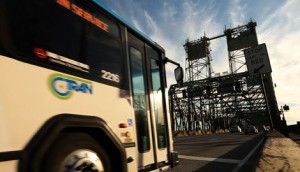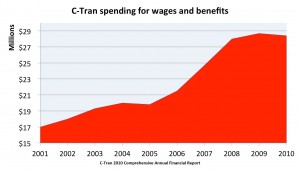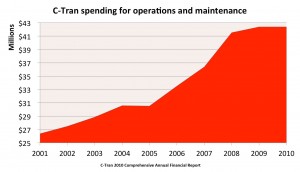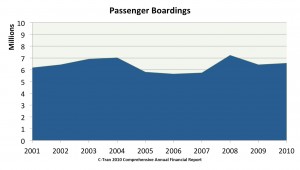C-Tran says Prop. 1 is all about preserving bus service.
However, this proposed 0.2 percent sales tax hike is the first step in C-Tran’s ambitious 20-year transit development plan, which calls for $332.5 million in new capital projects and an expansion of bus service, light rail, and bus rapid transit by 2030.
Currently, C-Tran is funded by a 0.5 percent sales tax. Prop. 1 would raise it to 0.7 percent, a 40 percent increase. As is, Washington State’s average sales tax is the 4fourh highest in the nation. C-Tran’s 20-year plan calls for this and several more sales tax increases over the next 10 years.
C-Tran claims it needs more money because its spending has become 48 percent higher than sales tax revenues.
Rather than cut spending, C-Tran has been tapping unrestricted savings. Its savings balance of $49.7 million is on track to be depleted in around two years. C-Tran has $114.7 million in total net assets.
Board approves light rail without vote
C-Tran is governed by a 10-member board of directors comprised of the three Clark County Commissioners, one non-voting labor representative, and City Council members representing each of the eight cities in Clark County.
Board members Bart Hansen and Larry Smith of the Vancouver City Council and La Center mayor Jim Irish are running for re-election in their respective jurisdictions, and Camas City Council member Linda Dietzman is being challenged by write-in candidate Steve Bang.
This year, the C-Tran board gave final approval of the final environmental impact statement (FEIS) of the $8.7 billion CRC light rail project without a vote of the people. The FEIS has now been submitted to the federal government for federal funding.
Last year, the C-Tran board also approved its own 20-year plan, which will roll out in two phases. The first phase calls for $168.3 million in new capital projects funded by $116.3 million in grants, $24.5 million in C-Tran funds, and $27.4 million in new debt.
However, completion of this phase depends solely on the passage of Prop. 1 and another 0.1% sales tax increase in 2012 to fund the operation and maintenance of light rail and bus rapid transit.
Phase two will cost $164.1 million, with $66.8 million in C-Tran capital funds and $18.6 million in additional debt. C-Tran also expects to request yet another 0.2 percent sales tax increase — for a total of .9 percent tax — for bus and C-VAN service sometime after 2020.
At that point, C-Tran will have maxed out its taxing authority for bus service, which state law limits to 0.9 percent. But because C-Tran is pursuing light rail and bus rapid transit, state law will grant C-Tran an entirely new taxing authority and an additional 0.9 percent cap, for an overall taxing potential of 1.8 percent. Next year’s proposed vote for light rail and bus rapid transit will count against this new cap.
If C-Tran’s financial statements are any indication, the agency will use these funds to continue to grow. Over the last decade, C-Tran spending has increase by 60 percent, from $26.3 million to $42.3 million.
In 2008, C-Tran spent $11.3 million on 20 new buses, using a combination of federal grant funding and its own capital. These included a dozen new hybrid buses, each costing more than $617,000 ($7.4 million total), with C-Tran’s local contribution at $1.4 million.
As compared to a regular diesel bus, the hybrid option adds $220,000 to the cost of a single vehicle. But hybrids only save 15 cents per mile. After the 12-year life of a bus with 1 million miles, rather than saving money, the hybrid option results in a net loss of $195,000.
When the recession hit, sales tax and investment revenues dipped and C-Tran saw net reductions of assets of $2.5 million in 2009 and $405,205 in 2010. The agency eliminated 35 positions from its 2011–2012 budget through layoffs, early retirements, and unfilled positions.
 However, 80 percent of C-Tran’s employees are unionized and continue to receive step increases, bringing the net effect to only three percent cut in wages and salaries and less than a one percent cut in benefits. C-Tran still faces binding arbitration with its drivers’ union, Amalgamated Transit Union, Local 757, whose members have been working without a contract since 2010.
However, 80 percent of C-Tran’s employees are unionized and continue to receive step increases, bringing the net effect to only three percent cut in wages and salaries and less than a one percent cut in benefits. C-Tran still faces binding arbitration with its drivers’ union, Amalgamated Transit Union, Local 757, whose members have been working without a contract since 2010.
In the meantime, C-Tran’s 2011–2012 biennium budget includes such items as $500,000 to help garner transit funding, $460,000 for election costs to raise taxes, $426,000 to analyze bus rapid transit, $6 million as matching funds for grants, and $1.2 million for its vehicle replacement program.
C-Tran’s history of spending
C-Tran’s long history of spending, with no significant long-term growth in ridership, means that in the last decade the cost per operating hour has jumped 49 percent for fixed routes ($67 to $100) and 51 percent for C-VAN direct response ($58 to $88).
Rather than restoring efficiency, the C-Tran board says it will slash bus service by 35 percent, hurting the poor and needy. While there are adequate alternatives for half of the routes threatened, riders in outlying areas – such as Salmon Creek, Yacolt, and Camas – will have no alternatives.
Even so, C-Tran will retain its express bus to Portland’s Oregon Health and Science University complex, although this location can be easily accessed via transfers to Tri-Met routes.
Whether or not voters support C-Tran’s long range plans, they should be aware that approving Prop. 1 amounts to an endorsement of C-Tran’s continued aggressive growth in size and cost, as outlined in its own 20-year plan.
Given the economic crisis, record unemployment, housing foreclosures, and failing businesses in Clark County, voters should ask themselves whether this the time to dramatically increase the size and cost C-Tran.
If a return to efficient and cost effective management is a priority, then voters can reject Prop. 1 and elect new board members.
It’s all a matter of priorities.
C-Tran is governed by a board of directors comprised of the three Clark County Commissioners and City Council members representing each of the eight cities in Clark County.
The C-Tran board members that are running for re-election are:
Bart Hansen, Vancouver City Council – challenged by Josephine Wentzel
Larry Smith, Vancouver City Council – challenged by Cory Barnes
Linda Dietzman, Camas City Council – challenged by write-in candidate Steve Bang
Jim Irish, City of La Center mayor – challenged by Troy Van Dinter













